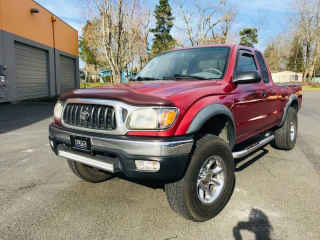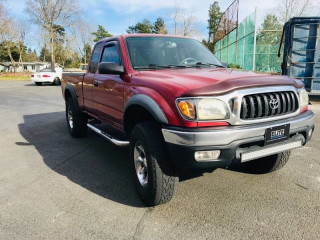The Good
The 2003 Toyota Tacoma excels in bulletproof reliability, delivering consistent performance whether for daily commutes or rugged adventures. Its practical design offers strong utility, while surprisingly good fuel efficiency for a truck and exceptional resale value appeal to the financially astute. Emotionally, it inspires confidence and a sense of freedom, making it a beloved choice for its "go-anywhere, do-anything" spirit.
The Bad
Known weaknesses for the 2003 Toyota Tacoma primarily involve significant frame rust, which can compromise structural integrity. Lower ball joint failures are also a critical safety concern. Other issues can include head gasket leaks on the 3.4L V6 and occasional automatic transmission problems, all of which demand thorough pre-purchase inspection.
2003 Toyota Tacoma: Quick Overview
- Engine Options: The 2003 Toyota Tacoma offered a range of robust powertrains. These included a 2.4-liter 4-cylinder, a 2.7-liter 4-cylinder (often found in 4x4 models), and a potent 3.4-liter V6 engine.
- Horsepower:
- 2.4L I4: Approximately 142 horsepower and 160 lb-ft of torque.
- 2.7L I4: Approximately 150 horsepower and 177 lb-ft of torque.
- 3.4L V6: Approximately 190 horsepower and 220 lb-ft of torque. This V6 was the most popular choice for those needing more power and towing capability.
- 2.4L I4: Approximately 142 horsepower and 160 lb-ft of torque.
- Fuel Economy (EPA Estimates, varies by drivetrain and transmission):
- 2.4L 2WD Manual: Around 20 MPG city / 26 MPG highway.
- 2.7L 4WD Manual: Around 18 MPG city / 20 MPG highway.
- 3.4L V6 2WD Automatic: Around 17 MPG city / 20 MPG highway.
- 3.4L V6 4WD Automatic: Around 16 MPG city / 19 MPG highway. Overall, the Tacoma was quite efficient for a compact truck of its era.
- 2.4L 2WD Manual: Around 20 MPG city / 26 MPG highway.
- 0-60 MPH Times: These trucks were not built for speed, but estimates typically fall in these ranges:
- 2.4L I4: Approximately 10-11 seconds.
- 3.4L V6: Approximately 8-9 seconds, making it reasonably brisk for a pickup.
- 2.4L I4: Approximately 10-11 seconds.
- Towing Capacity: Varies significantly by engine and configuration.
- With the 3.4L V6 engine and a proper towing package, the 2003 Tacoma could tow up to 5,000 pounds, making it suitable for small boats or utility trailers.
- 4-cylinder models had lower capacities, typically in the 2,500-3,500 pound range.
- With the 3.4L V6 engine and a proper towing package, the 2003 Tacoma could tow up to 5,000 pounds, making it suitable for small boats or utility trailers.
- Trim-Level Features:
- Base: A utilitarian work truck with basic amenities like manual windows and locks, AM/FM radio, and vinyl or cloth seats.
- SR5: Added comfort and convenience features such as air conditioning, power windows and locks, chrome exterior accents, upgraded cloth interior, and a tachometer.
- PreRunner: Available in 2WD but featured the raised suspension and aggressive styling of 4x4 models, often with larger tires. It was essentially a 2WD off-road look-alike.
- TRD Off-Road Package: Enhanced off-road capability with a locking rear differential, Bilstein shocks, unique wheels, and aggressive tires. This was a popular option for enthusiasts.
- S-Runner: A rare, sport-oriented trim available only with the 3.4L V6 and manual transmission. It featured a lowered suspension, specific alloy wheels, sport seats, and body-colored bumpers.
- Double Cab: Offered four full doors and a back seat, exclusively available with the 3.4L V6 engine, providing more passenger space but typically a shorter bed length.
- Base: A utilitarian work truck with basic amenities like manual windows and locks, AM/FM radio, and vinyl or cloth seats.
2003 Toyota Tacoma Specifications
Vehicle Information
| Year | 2003 |
| Make | Toyota |
| Model | Tacoma |
| Trim | - |
| Style | Double Cab 4WD V-6 Automatic |
| Type | Pickup Truck |
| Category | Small Pickup Truck |
Manufacturing Details
| Made In | Japan |
| Manufacturing City | FREMONT |
Dimensions
| Doors | 2-Door |
| Curb Weight | 1605.72 kg |
| Gross Vehicle Weight Rating | 2313.32 kg |
| Overall Height | 171.45 cm |
| Overall Length | 515.37 cm |
| Overall Width | 168.91 cm |
| Wheelbase Length | 309.63 cm |
| Standard Seating | 5 |
Engine & Performance
| Engine | 3.4-L V-6 DOHC 24V |
| Engine Size | 3.4L |
| Engine Cylinders | 6 |
| Transmission | 5-Speed Manual |
| Transmission Type | Manual |
| Transmission Speeds | 5-Speed |
| Drivetrain | Four-Wheel Drive |
Additional Features
| Anti-Brake System | Non-ABS 4-Wheel ABS |
| Steering Type | Rack & Pinion |
Pricing
| Manufacturer Suggested Retail Price (MSRP) | $19,820 USD |
| Invoice Price | $17,936 USD |
| Delivery Charges | $510 USD |
Vehicle History Report
Specifications
History
Events
History Check
Check
Check
Check
Check
Listings
Recalls
Check
Analysis
What Problems Does the 2003 Toyota Tacoma Have?
The most notorious problem is severe frame rust. This affects many first-generation Tacomas (1995-2004), and the 2003 model year is particularly susceptible. Rust can compromise the structural integrity of the frame, leading to safety concerns and even complete failure. Toyota issued a massive recall and conducted a buyback program or frame replacement for affected vehicles. Prospective buyers absolutely must inspect the frame thoroughly for corrosion, especially near the rear leaf spring mounts and suspension components. A vehicle that has not had its frame addressed could be a significant liability.
Another critical issue is lower ball joint failure. Toyota issued a recall for this problem as well, as a failed ball joint could cause the wheel to separate from the vehicle while driving. Owners should ensure this recall service has been performed. Early symptoms often include clunking noises over bumps or loose steering.
The 3.4-liter V6 engine, while robust, can occasionally suffer from head gasket leaks. This is not as widespread as the frame rust or ball joint issue, but it's a known concern, particularly in higher mileage examples. Symptoms include coolant loss, overheating, or white smoke from the exhaust.
Automatic transmissions, specifically the A340F/E, are generally reliable but can experience issues such as delayed shifts, harsh shifting, or solenoid failures over time, especially if fluid changes have been neglected.
Minor issues include oxygen sensor failures, which can trigger a check engine light and affect fuel economy, and occasional power steering leaks from hoses or the pump itself. Fuel sender units in the tank can also fail, leading to inaccurate fuel gauge readings.
While these issues can be significant, the Tacoma's core mechanical components (engine, transmission) are otherwise very durable when maintained, which is why diligent maintenance and addressing these known flaws are crucial for long-term ownership.
How long will the 2003 Toyota Tacoma last?
What Technology & Safety Features are Included?
Built-in Tech & Entertainment:
Standard equipment was basic, often including an AM/FM radio with two speakers. Higher trims and optional packages could include a CD player (sometimes with a cassette player), an upgraded sound system, and perhaps more speakers. Climate control was manually operated, featuring simple dials for temperature, fan speed, and vent selection. There were no integrated navigation systems, Bluetooth connectivity, or USB ports; these are all aftermarket additions for a 2003 Tacoma. Power windows and door locks were optional on base models and standard on higher trims like the SR5 and Double Cab.
Driver-Assistance Features:
True driver-assistance features as we know them today (e.g., adaptive cruise control, lane-keeping assist) were non-existent. The most sophisticated 'assistance' would be optional cruise control, typically available on SR5 and V6 models.
Safety Features:
Safety features were also quite basic:
- Airbags: Driver and front passenger airbags were standard.
- Anti-lock Braking System (ABS): ABS was an optional feature, primarily on V6 models and some 4WD configurations. Base 4-cylinder 2WD models often came without ABS.
- Seatbelts: Three-point seatbelts were standard for all seating positions.
- Child Seat Anchors: LATCH (Lower Anchors and Tethers for Children) system might be present in later production first-gen models, particularly the Double Cab, but was not universally standard or as robust as modern systems.
Crash-Test Ratings:
Crash test results from the National Highway Traffic Safety Administration (NHTSA) and the Insurance Institute for Highway Safety (IIHS) from 2003 and prior years provide context:
- NHTSA: Frontal crash tests typically yielded a 4-star rating for both driver and passenger. Side-impact tests were generally not as strong, often showing concerns due to the lack of side airbags.
- IIHS: The IIHS rated the first-generation Tacoma as "Good" for frontal offset crashes, which was respectable for its time. However, due to the absence of side airbags, side impact ratings were typically "Poor" or "Marginal." Rear crash protection and roof strength were not always rated with the same rigor as today's standards.
Overall, the 2003 Tacoma offered essential safety equipment but lacked the advanced passive and active safety technologies found in contemporary vehicles.
What Colors Options are Available?
2003 Toyota Tacoma Prices and Market Value
2003 Toyota Tacoma Cost of Ownership
2003 Toyota Tacoma Fuel Efficiency
2003 Toyota Tacoma Safety Rating
NHTSA
IIHS
2003 Toyota Tacoma Warranty
Basic
Powertrain
Rust
2003 Toyota Tacoma Insurance
reasonable repair costs.
How Does the 2003 Toyota Tacoma Compare to Other Pickup Truck?
Performance: The Tacoma's 3.4L V6 (190 hp) offered competitive power, generally outclassing the Ranger's 4.0L V6 (around 207 hp but often less refined) and being on par or slightly better than the S-10's 4.3L V6 (up to 190 hp). The Tacoma's 4-cylinder options were robust but less powerful than some rivals. Its off-road prowess, especially with the TRD package, often surpassed that of standard Ranger or S-10 configurations.
Features: In terms of built-in tech and comfort features, all trucks in this segment were fairly basic. The Tacoma offered a similar level of amenities to its rivals, with power options, A/C, and CD players being common upgrades. No compact truck of this era boasted advanced safety or infotainment features. The Tacoma's Double Cab, introduced to the first generation, was a significant feature advantage for passenger space over the extended cabs of most rivals.
Reliability: This is where the Tacoma truly shone. While rivals like the Ranger and S-10 were reasonably reliable, the first-generation Tacoma developed a legendary reputation for bulletproof mechanicals that largely surpassed its competitors. Despite its known issues (frame rust, ball joints), once addressed, the core engine and drivetrain reliability was unmatched, leading to its exceptional longevity. The Nissan Frontier was also a strong contender for reliability, often considered second to the Tacoma.
Price: New, their prices were competitive. However, on the used market, the Tacoma consistently commands a higher price than its rivals due to its perceived (and often proven) superior reliability and resale value. A used 2003 Tacoma will almost always be more expensive than a comparable Ranger, S-10, or even Frontier from the same year.
Similar Alternatives:
- Nissan Frontier (First Generation, 1998-2004): A very close competitor in terms of reliability and off-road capability, often a more affordable alternative to the Tacoma on the used market. It also offered a V6 and different cab configurations.
- Ford Ranger (Third Generation, 1993-2011): Known for its simple, rugged design and robust V6 engines. While not as refined or reliable as the Tacoma, it's a solid, budget-friendly work truck with vast aftermarket support.
Recommendation: For someone prioritizing maximum long-term reliability and high resale value, the 2003 Tacoma is still the top choice, provided its specific known issues (frame rust, ball joints) have been thoroughly checked and addressed. If budget is a stricter constraint but reliability is still key, a first-generation Nissan Frontier is an excellent "better alternative." For a pure work truck on a tight budget, the Ford Ranger offers a more "similar alternative" experience, though with potentially higher long-term repair costs.


